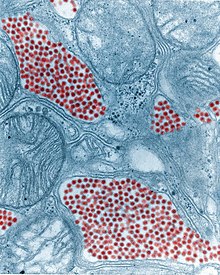Eastern equine encephalomyelitis
| Eastern equine encephalitis | |
|---|---|
| Classification and external resources | |
| ICD-10 | A83.2 |
| ICD-9-CM | 062.2 |
| MeSH | D020242 |
| Eastern equine encephalomyelitis | |
|---|---|
 |
|
| Colourised TEM micrograph of a mosquito salivary gland. The virus particles (virions) are coloured red. (83,900x magnification) | |
| Virus classification | |
| Group: | Group IV ((+)ssRNA) |
| Family: | Togaviridae |
| Genus: | Alphavirus |
| Species: | Eastern equine encephalitis virus |
Eastern equine encephalitis (EEE), commonly called Triple E or, sleeping sickness (not to be confused with Trypanosomiasis) is a zoonotic alphavirus and arbovirus present in North, Central and South America and the Caribbean. EEE was first recognized in Massachusetts, United States in 1831 when 75 horses died mysteriously of viral encephalitis. Epizootics in horses have continued to occur regularly in the United States. It can also be identified in asses and zebras. Due to the rarity of the disease its occurrence can cause economic impact in relation to the loss of horses and poultry. EEE is found today in the eastern part of the country and is often associated with coastal plains. It can most commonly be found in east and gulf coast states. In Florida about one to two human cases are reported a year although over sixty cases of equine encephalitis are reported. Some years in which there are favorable conditions for the disease there number of equine cases are over two-hundred. Diagnosing equine encephalitis is challenging because many of the symptoms are shared with other illnesses and patients can be asymptomatic. Confirmations may require a sample of cerebral spinal fluid or brain tissue although CT scans and MRI scans are used to detect encephalitis. This could be an indication that the need to test for Eastern Equine Encephalitis is necessary. If a biopsy of the cerebral spinal fluid is taken it is sent to a specialized laboratory for testing.
EEEV is closely related to Venezuelan equine encephalitis virus and Western equine encephalitis virus.
There are two ways in which the virus can progress, systematic and encephalitic, depending on the person's age. Encephalitic involves swelling of the brain and can be asymptomatic while the systemic illness occurs very abruptly. Those with the systemic illness usually recover within one to two weeks. While the encephalitis is more common among infants in adults and children it usually manifests after experiencing the systemic illness. Symptoms include high fever, muscle pain, altered mental status, headache, meningeal irritation, photophobia, and seizures, which occur three to 10 days after the bite of an infected mosquito. Due to the virus's effect on the brain, patients who survive can be left with mental and physical impairments such as personality disorders, paralysis, seizures, and intellectual impairment
...
Wikipedia
